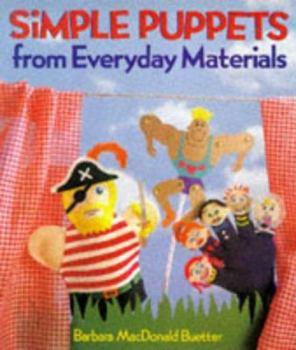Simple Puppets from Everyday Materials
Showing children how to make puppets following basic instructions, this colourful book has instructions for making puppets by gluing on to an ice-cream stick, and making a snake puppet using an old... This description may be from another edition of this product.
Format:Hardcover
Language:English
ISBN:1895569052
ISBN13:9781895569056
Release Date:December 1996
Publisher:Sterling
Length:80 Pages
Weight:0.45 lbs.
Dimensions:0.5" x 8.7" x 10.2"
Age Range:9 to 12 years
Grade Range:Grades 4 to 7
Customer Reviews
2 ratings
Simply Wonderful!
Published by Thriftbooks.com User , 20 years ago
I bought this book when I started my Day Care business, and needed ideas for simple puppets. This book turned out to be the best out of a series of books I purchased in terms of offering ideas for me and the children. I really like that the ideas for the puppets are based on simple materials that you can find anywhere - including leftover supplies in your own home, like toilet paper rolls or orange juice cans. This teaches children to be resourceful and productive, and to use their imaginations.Also, the ideas really work well. The puppets are simple, but there are enough ideas to build on that you could make really complex mechanical puppets, or moveable puppets if you like. This is a book that you and your children could grow on. I don't think, however, that if you are going to do art-puppets, this book would be for you, but it would be a good start for someone who has never made puppets before and wanted to get a good start.The author, Barbara MacDonald Buetter, goes over at least a dozen different types of puppets and many different ways to decorate them. My children never tired of making the puppets. Finally, MacDonald Buetter gives ideas to build different types of theaters, from simple to more complex, and so we had a little puppet show! Wow!
A Must-Have!
Published by Thriftbooks.com User , 23 years ago
Simple Puppets from Everyday Materials by Barbara MacDonald Buetter (New York: Sterling Publishing Co, Inc. 1998) is a great resource for imaginative construction of puppets. There is a strong focus on the use of recycled materials. She recommends keeping a box of such materials as paper tubes and plastic tabs just for such projects (and at last I've found a use for all the junk I've been saving!) and lists a slew of materials found in everyday life. These materials are great for use in the classroom since they are so easy to accumulate. The teacher can save such materials and send out a "wish list" to parents to encourage children to recycle and to use their imaginations to solve 3-dimensional building and visual problems. She starts off with basic construction. Well-drawn, colorful diagrams illustrate how to braid, make chains, create 3-dimensional noses, crowns and cone hats. She instructs the reader to make faces in a mirror and practice drawing different expressions to show feeling and exaggerated feeling. She'll use spoons for a head and body, a glove for a family of people or ducks or a bee with flowers, a folded carton with inside straps as a hinged mouth, upside-down cans as heads, basic hand puppets with variations such as a kangaroo's pouch, wrestlers, jitterbugs and ballerinas with brass-fastener arms and legs, paper plate suns and Humpty-Dumpties with finger legs, tube-sock puppets, papier-mache puppets, and on and on. She even shows how a little salt sprinkled on wet paint can add great texture. There are even instruction of how to make different stages. Carrots and bananas make fun, if temporary, puppets with tooth pick attachments and pretzel eye-glasses. Some of her most ingenious use of materials are the creation of movable parts. Linked ring paper chains easily move as marionette arms and legs (and trunks!) and even a caterpillar's body. A folded plastic lid makes a very durable "hinged" mouth. Accordion-folded paper makes for great caterpillars and jack-in-the-boxes. She even creates a dragon as variation, adding wings and an appropriate head. The puppet is moved by popsicle sticks affixed at opposite ends. Popsicle Stick puppets can move by hand movements alone, or be pushed upward through a paper cup to create to illusion of, say, a growing flower. She has a variation of a jumping-jack puppet using a spool, a straw and string. With a slightly larger tube over a smaller one, heads can turn, change expression or character, or if moved up and down, have eyes or mouths that open and close. She's very interested in exploring a full range of possibilities and encourages the reader to also do so. Her projects encourage the use of imagination. The examples she uses are colorful and she'll even present multiple variations on one idea. There is a full range of characters presented, from people, to animals, to insects, to robots, and more. But she presents these only as guidelines, calling for the students' use




